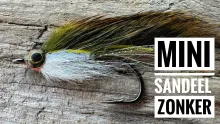The Kavik is a simple zonker-based streamer, well suited for a lot of different fish, and easy to adapt in color and material choice
This was a fly that I noticed, when its originator, Polish Kuba Chruszczewski posted it on Facebook. It was obvious to see that this was an efficient fishing fly, and when Kuba posted the step-by-step, it was also quite obvious that it was a simple and easy fly to tie.
Kuba calls his fly Kavik – wolverine in the Inupiaq language, spoken by the Iñupiat, a group of Alaska Natives. Wolverine might be best known as the name of Hugh Jackman’s character from Marvel’s X-Men comics and movies, but it’s actually a pretty fearsome and feisty animal, related to otters, badgers and weasels. It’s realm is the large forests of the northern hemisphere.
The Kavik is quite like the wolverine in coloration, so the name is very fitting.
The fly is very simple, basically using two materials: flash and a zonker strip. You do need two different kinds of flash, though: a stiff one for the underwing and a softer one for mixing into the hair hackle.
The finished fly will do very well as both a fly for the sea run browns of the Baltic and brown trout in streams. It will serve as a bass fly for those pursuing large and smallmouth bass and – perhaps with some color variations – it would serve well as a traditional saltwater pattern, tied small and tan for bonefish as well as large and more colorful for tarpon.
You can add various accents to the fly, like mixing different colors of hair or flash, or tie in a false hackle and add rubber legs behind or in the hackle for even more movement.
A bunch of rigid Crystal Flash will serve as a support for a zonker strip. The fur is rabbit, chestnut brown with some darker tips. Any color can be used, but this hue suits the pattern very well, and makes it live up to its name.
The hackle is the same rabbit hair, cut off the skin strip and mixed with some flash and spun to a fuzzy brush. The easiest way to do this, is using a clip. Leave the hair on the skin, lay some flash straws on top of it and grab it with the clip, hair tips pointing into the clip and the skin strip just outside the jaws. Then trim off the skin strip, leaving the hairs clamped in the clip,
The hair butts are then put between two threads forming a dubbing loop, and spun to create the dense brush, which can be wrapped as a hackle while the hairs are stroked back to avoid trapping them.
When the hackle has been wrapped and tied down, you can brush the it with Velcro stick or toothbrush to get it to sweep back over the fly.
Susanne Nilsson
- Log in to post comments


















no doubt, this fly will catch fish
What I particularly like about this type of fly is that even if it is lost in the mouth of a big pike or a big lake trout, you don't have the impression of seeing hours of work disappear in the bottom of the lake…which happens to me :-)